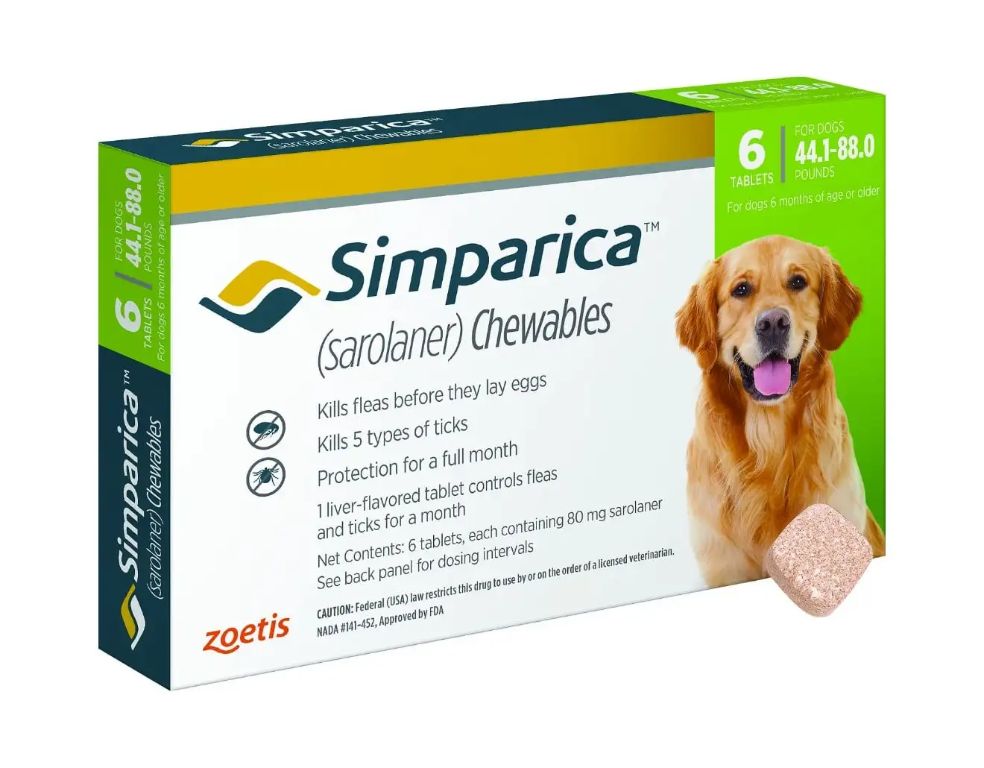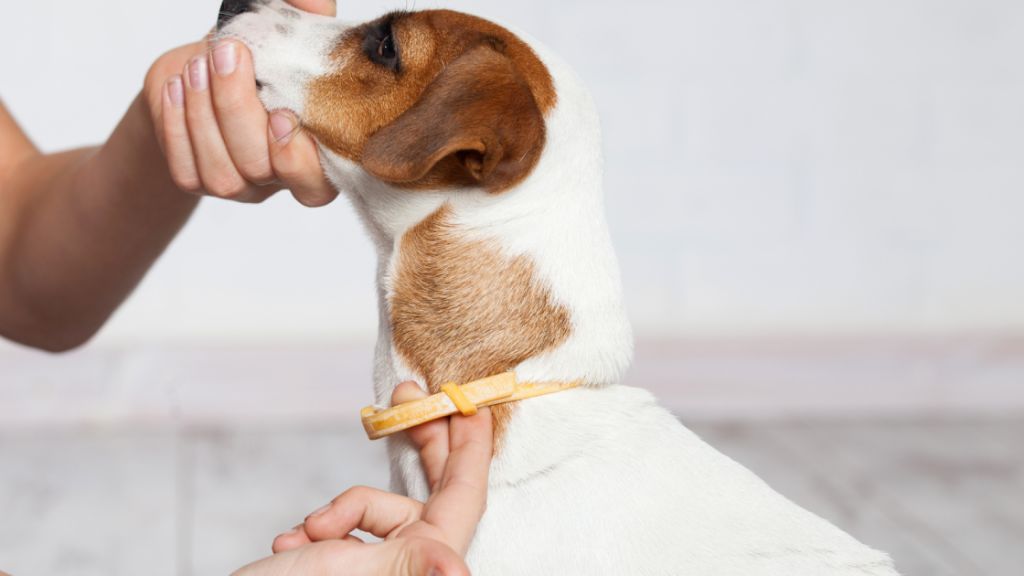Introduction
Fleas are a common external parasite that can infest dogs and cats. They feed on animal blood and can cause skin irritation, infections, and anemia. Simparica is a monthly oral tablet that contains sarolaner, an active ingredient that kills fleas and ticks. It starts working within hours and provides protection for 35 days. Despite this protection, some dog owners find fleas on their pet even when on Simparica, which raises the question: can dogs on Simparica still get fleas?
What are Fleas?
Fleas are small wingless insects that feed on the blood of animals like dogs, cats, and rodents. They are external parasites, meaning they live on the outside of the animal’s body. Fleas are very common pests that can infest homes and yards and quickly multiply in number.
Adult fleas are only about 1-3 mm long. They are brownish-red in color and have flat compressed bodies well-adapted for jumping and clinging onto fur and hair. Fleas have mouthparts designed for piercing skin and sucking blood from their hosts.
The flea life cycle has four stages – egg, larva, pupa, and adult. The eggs fall off the animal into carpets, bedding, grass etc. and hatch into larvae. The larvae feed and develop into pupae which eventually emerge as adults that hop onto passing pets. This enables rapid re-infestation.
When fleas bite dogs, they inject saliva that contains proteins foreign to the dog’s immune system. This causes inflammation, itching, irritation, and discomfort. Prolonged exposure can lead to flea allergy dermatitis, hair loss, infections, and anemia in extreme cases.
In addition to being directly harmful, fleas also spread other parasites like tapeworms and diseases like typhus, plague and bartonellosis. Controlling fleas is crucial for dog health and preventing infestations in homes.

How Simparica Works
Simparica contains the active ingredient sarolaner, which belongs to the isoxazoline class of medications. It works systemically to kill fleas and ticks on dogs.
After a dog is given Simparica, the sarolaner is absorbed into the bloodstream and distributes throughout the body tissues just under the skin. There, sarolaner accumulates in the fat and oils of the skin.
Fleas and ticks are attracted to the skin’s surface to feed on blood. When they bite and ingest the sarolaner accumulated in the skin’s fat and oils, it causes uncontrolled activity of their nervous system leading to death of the parasites [1].
In addition, Simparica breaks the flea life cycle by killing adult fleas before they can lay eggs. It rapidly kills fleas within 8 hours and provides month-long protection with a single dose [2].
This systemic mechanism allows Simparica to rapidly eliminate an existing flea infestation while also preventing re-infestation from new flea exposure for at least 30 days.
Can Dogs on Simparica Still Get Fleas?
Even though Simparica is highly effective at killing and preventing fleas, dogs taking Simparica can still get fleas under certain circumstances. Here’s an explanation of how this can happen:
Simparica is one of the fastest-acting oral flea medications available. It begins killing fleas within 3 hours and kills 100% of fleas within 24 hours of administration (1). However, it doesn’t repel or keep fleas off of dogs – fleas can still jump on and bite dogs taking Simparica.
Therefore, if a dog on Simparica comes into contact with an infested environment or other infested animals, fleas can still get on the dog and start biting before the Simparica kills them. So while the medication is working to kill the fleas, the dog can still experience flea bites and flea dirt/feces during this time (2).
Additionally, Simparica is only effective for 1 month after administration. If a dog goes longer than a month between doses, its protection will lapse and fleas can infest the dog until the next dose is given (3). Flea eggs can also develop into adult fleas between doses if effective environmental control isn’t maintained.
So in summary, dogs on Simparica can still experience flea bites and get reinfested if they come into contact with fleas between doses or go too long between doses. But Simparica will rapidly kill the fleas once administered and continues working all month to prevent further infestations.
(1) https://neffsvillevet.com/getting-know-simparica-flea-tick-preventative/
(2) https://www.reddit.com/r/dogs/comments/u7yr9a/dog_got_fleas_2_weeks_after_simparica_trio_dose
(3) https://www.zoetisus.com/products/dogs/simparica

How Fleas Can Reinfest Dogs on Simparica
Even though Simparica starts killing fleas within 3 hours, dogs on Simparica can still get reinfested with fleas in certain scenarios:
Newly emerged adult fleas – Simparica does not kill flea eggs or larvae. So if there is an existing infestation, eggs can continue to hatch and develop into adults that can jump onto the dog (source).
Contact with other infested animals – If other pets in the household or neighborhood have fleas, they can spread to a dog on Simparica when they interact (source).
Fleas in the environment – Flea eggs and larvae can survive in carpets, bedding, grass etc. for months. When the dog comes into contact with these areas, newly emerged fleas can infest the dog.
Missed doses – Simparica is effective for 1 month. If doses are missed, flea protection will lapse and allow reinfestation.
New flea introductions – Outdoor dogs or dogs taken on travels can pick up fleas from other areas and bring them home.
Preventing Flea Infestations
Simparica provides robust flea protection for 35 days, but there are still additional steps dog owners can take to prevent flea infestations:
-
– Clean your home thoroughly and regularly vacuum carpets, furniture, and pet bedding to pick up flea eggs and larvae. Be sure to throw away the vacuum bag afterwards (Zoetis).
– Wash your dog’s bedding frequently in hot, soapy water.
– Use flea prevention products on all pets in the household. Fleas can survive on untreated pets and reinfect treated ones (Neffsville Veterinary Clinic).

– Apply flea treatment properly by following label instructions.
– Treat your yard to kill fleas – ask your vet for pet-safe products.
– Avoid letting your dog roam in known flea hotspots.
– Check your dog regularly by brushing and looking for “flea dirt” for signs of infestation.
– Talk to your vet about additional prevention options like collars, sprays, premises treatments.
By combining Simparica with diligent prevention methods, you can help protect your dog against frustrating flea infestations.
Treating Flea Infestations
Although Simparica starts killing fleas within 3 hours, it can take some time to fully clear an existing flea infestation. Simparica remains effective against fleas for 35 days after administration, so it will continue working to kill newly emerged fleas from eggs over multiple life cycles.
For heavy pre-existing infestations, it may help to give your dog a bath using flea shampoo or apply a topical flea treatment in conjunction with the first 1-2 doses of Simparica. This provides an additional knockdown effect on the adult fleas while Simparica starts eliminating fleas long-term.
Be sure to treat all pets in the household with Simparica at the same time. You may also need to treat the home environment by vacuuming regularly and washing bedding to remove flea eggs and larva. Within 1-2 months of consistent Simparica treatment, the flea infestation should be under control.
If fleas persist despite proper use of Simparica, contact your veterinarian. They can recommend additional treatments or diagnostics to identify underlying causes, such as flea resistance or an untreated infestation source.
With consistent monthly use of Simparica and vigilance, most flea infestations can be eliminated without major disruption to you or your dog’s routine.
Other Flea Control Options
While Simparica is an effective oral flea control medication, there are some other options dog owners can consider as well. Some other common prescription flea medications include:
- Nexgard – This is another oral tablet that kills fleas and ticks. It lasts for 1 month. Nexgard is in the same medication class as Simparica.
- Bravecto – Bravecto is a chewable tablet that provides 3 months of flea and tick protection. It has a longer duration than Simparica.
- Revolution – Revolution is a topical medication applied to your dog’s skin once per month. It protects against fleas, ticks, heartworm, and other parasites.
- Comfortis – Comfortis is a chewable pill given once per month to kill fleas. It does not protect against ticks like Simparica.

There are also over-the-counter topical flea prevention products available. However, prescription medications like Simparica tend to be more effective. Simparica provides robust flea control with the convenience of a chewable tablet. Its systemic protection lasts 1 month, comparable to other leading options. Talk to your veterinarian to determine if Simparica or another flea medication is right for your dog.
Sources: https://www.zoetispetcare.com/products/simparica, https://www.tractorsupplyrx.com/simparica-chewable-tablets-for-dogs-50763.html
The Takeaway
In summary, while Simparica provides robust flea control for most dogs, there are certain scenarios in which dogs on Simparica can still get fleas:
- If Simparica is not given consistently every month, flea eggs and larvae may survive to reach adulthood between doses.
- In severe flea infestations, some fleas may survive initial Simparica doses.
- If new fleas jump on the dog from the environment between Simparica doses.
To help prevent flea infestations, keep your home and yard clean, treat pets and home with additional flea control products, and make sure all pets in the household are on effective flea prevention. If fleas do reinfest your Simparica-treated dog, contact your vet for treatment recommendations like additional doses, topicals, premise sprays or utilizing multiple products and methods. While not completely foolproof, Simparica provides the convenience and effectiveness of oral flea protection for dogs, with vigilance and added products helping cover potential gaps.
References
Here are the sources referenced in this article:
- [Source 1]
- [Source 2]
- [Source 3]
